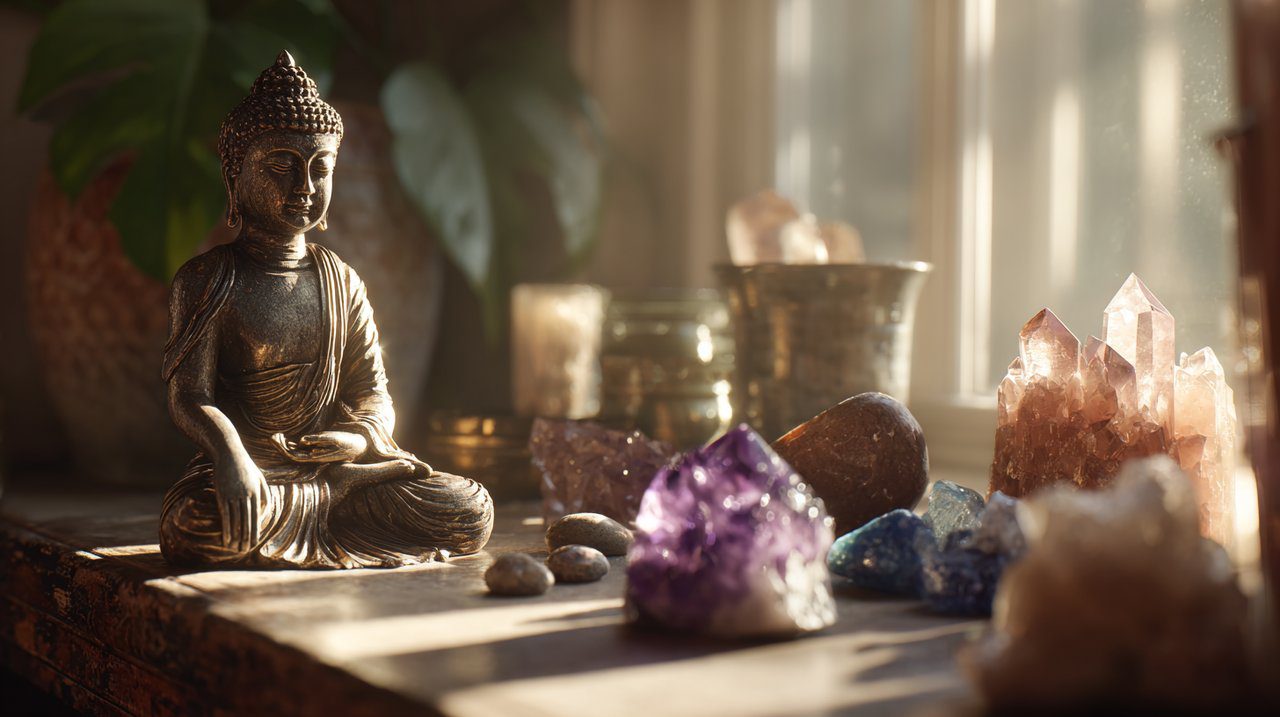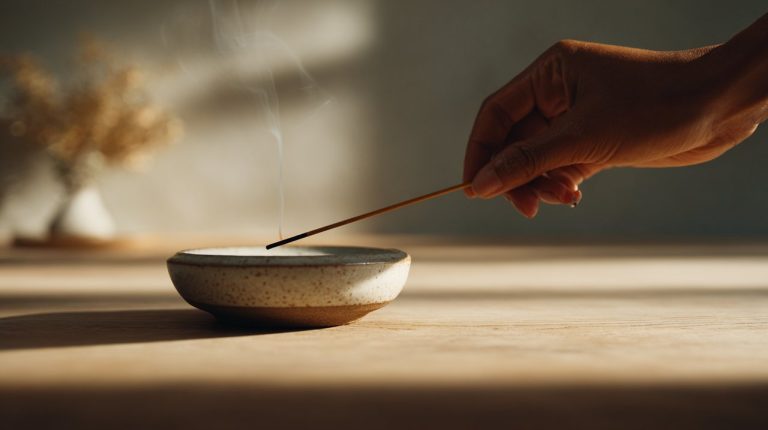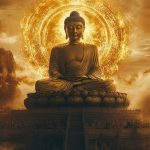The Medicine Buddha Image: A Visual Prescription for Holistic Healing
In our modern quest for holistic well-being, many of us turn to ancient wisdom traditions, seeking practical tools for inner harmony. Among these, the Medicine Buddha image offers a systematic framework for healing across physical, mental, and spiritual dimensions.
This revered figure, known in Sanskrit as Bhaisajyaguru—the “Master of Medicine, King of Lapis Lazuli Light”—embodies the enlightened qualities essential for alleviating suffering. By understanding its intricate symbolism, engaging in focused meditation, and ensuring its thoughtful placement, we can truly grasp the transformative insights this ancient spiritual guide provides.
The Medicine Buddha image is far more than just an artistic representation; it is a visual prescription. Every element within it contributes to what we might call an inner pharmacy of health and balance.
The Visual Prescription: Deconstructing the Medicine Buddha Image for Healing
The iconography of the Medicine Buddha is rich with symbolic elements. Each is carefully designed to represent his vows, healing abilities, and enlightened qualities. Understanding these components allows practitioners to engage more deeply with the healing potential embedded within each “medicine buddha image”.
The Azure Hue: A Canvas of Cosmic Healing
The Medicine Buddha is typically depicted in a bright, lapis lazuli blue. This color is deeply associated with purity, healing, and infinite wisdom. It symbolizes the healing properties of lapis lazuli, a stone traditionally linked to health, protection, and truth.
More profoundly, this deep blue hue represents the vast, clear mind that accompanies enlightenment—a mind capable of transforming even anger into wisdom and intelligence. Visualizing this glowing blue body serves as a powerful reminder that suffering can be transcended, and transformation is always possible through compassion and wisdom.
Mudras and Implements: Gestures of Compassion, Tools of Transformation
The hand gestures, or mudras, and the implements held by the Medicine Buddha are fundamental to his visual prescription. His right hand typically rests over his right knee in the Varada Mudra, the gesture of granting boons or blessings. This symbolizes his vow to alleviate suffering and bestow healing power.
In the same hand, between the thumb and index finger, he often holds a sprig of the myrobalan plant (Arura plant). This sacred herb is renowned for its potent medicinal properties, capable of curing various illnesses and promoting vitality and balance.
His left hand, resting on his lap, cradles a bowl filled with medicinal nectar or herbs, often depicted as a lapis lazuli jar. This bowl signifies his profound capacity to cure both physical and spiritual ailments, offering an elixir that purifies negative karma and fosters enlightenment.
The Auspicious Aura: Decoding the Sacred Attributes
Beyond the central mudras and implements, several other attributes enhance the healing symbolism of “medicine buddha images”.
- He is often seated in the Dhyana Aasan, a meditative posture with crossed legs on a lotus petal pedestal, symbolizing meditative stability.
- A radiant halo or prabhamandala of healing light typically envelops the Medicine Buddha. This represents his transcendent quality and ability to illuminate suffering, signifying boundless mercy and wisdom.
- He wears simple monastic robes, which symbolize renunciation, humility, and discipline. These robes are often adorned with gold, representing the light of enlightenment.
Cultivating Inner Pharmacy: Medicine Buddha Meditation Practices
Engaging with the Medicine Buddha through meditation is a direct way to connect with its healing energies. It transforms the visual prescription into a lived, personal experience, addressing not only physical illness but also mental pain and spiritual challenges.
Visualizing the Healing Radiance: A Step-by-Step Guide
Central to Medicine Buddha meditation is the visualization of his blue shining form. Practitioners imagine the Medicine Buddha seated on a lotus throne, his body radiating a brilliant lapis lazuli light.
This light is then visualized moving outwards, entering your own body, and gently dissolving sickness, adverse moods, and karmic obscurations. The light then extends further, reaching all beings, bringing universal healing.
To begin, find a comfortable position, focus on your breath, and then gently visualize the “medicine buddha picture” in front of you, allowing the radiant blue light to fill your entire being.
Integrating Mantra and Mindfulness with Your Image
Mantra chanting is a vital component of Medicine Buddha practice. It significantly enhances both visualization and focus. The Medicine Buddha mantra, “Tadyatha Om Bhekhaze Bhekhaze Maha Bhekhaze Bhekhaze Radza Samungate Swaha,” is recited to invoke healing energy.
Traditionally, this mantra is repeated 108 times, often with the aid of mala beads to maintain count and focus. Some practices even involve reciting the mantra over a glass of water, which is then consumed, believed to infuse the water with healing properties.
Integrating mindfulness means sustaining awareness throughout the practice. It’s about recognizing that true healing begins in the mind, by pacifying negative emotions and ignorance.
Beyond the Image: Sustaining Your Healing Practice
Sustaining a Medicine Buddha practice extends far beyond formal meditation sessions. It involves cultivating compassion for oneself and others, and dedicating the merit of one’s practice to all sentient beings.
This practice supports holistic solutions, thoughtfully combining meditation for the mind, mantras for speech, and healthy living for the body. Regularly engaging with the “medicine buddha image” and its associated practices can foster inner peace, support overall well-being, and bring vitality and a sense of longevity.
Sacred Space, Sacred Healing: Optimal Placement of Your Medicine Buddha Image
The thoughtful placement of a Medicine Buddha image or statue actively contributes to a harmonious and healing environment, amplifying its spiritual significance within your living space.
Creating a Sanctuary: Ideal Locations and Orientations
When placing a Medicine Buddha image, select a location that reflects deep respect and reverence. Ideal spots include a dedicated meditation room, a prayer room, or a quiet, serene corner of a living space.
The image should never be placed directly on the ground or floor. Instead, elevate it on a shelf or altar, ideally at least three feet above the ground. This shows respect and ensures the image remains a focal point.
While there are no strict directional rules, placing it in the east or south is often recommended for positive energy. Conversely, it is crucial to avoid placing the image in kitchens, bathrooms, or near refrigerators and heavy storage, as these areas can diminish its intended energy.
Enhancing the Energetic Field: Complementary Elements
To further enhance the energetic field around your “medicine buddha picture”, consider incorporating complementary elements. Healing crystals, for instance, can add positive energy to the altar space.
- Amethyst promotes calmness and spiritual growth.
- Rose quartz fosters love and compassion.
- Black tourmaline offers protection against negative energies.
- Lapis lazuli, often associated with the Medicine Buddha itself, enhances spiritual enlightenment and wisdom.
Integrating items that resonate with healing and protection can further personalize and deepen the sacred quality of your space.

Wisdom in Placement: Drawing from Ancient Traditions
Drawing from ancient traditions, the careful selection of placement and accompanying elements transforms a space into a sanctuary. Just as various symbols, like the elephant in many cultures, represent strength, wisdom, and good fortune, integrating such elements thoughtfully contributes to an overall atmosphere of stability and positive energy.
The overarching goal is to create an environment that actively fosters healing, mindfulness, and spiritual growth, whether for formal meditation or simply to cultivate a calming ambiance.
The Universal Healer: Bridging Ancient Wisdom with Modern Wellness
The Enduring Legacy of the Medicine Buddha
Introduced in the Medicine Buddha Sutra, this deity took twelve great vows after attaining enlightenment. Many of these specifically promise relief from illness and suffering. His teachings extend beyond merely curing physical ailments; they address the deeper roots of pain and suffering, such as greed, hatred, and ignorance. Across Mahayana Buddhist traditions, practitioners continue to recite his name and mantra to protect against sickness and disease, demonstrating his enduring relevance.
A Path to Personal Transformation
Engaging with the “Medicine Buddha image”, whether through visualization or mantra, is a clear path to personal transformation. It is a deeply effective practice for addressing physical, mental, and emotional ailments, capable of bringing about significant positive change.
By truly understanding the Medicine Buddha image as a comprehensive visual prescription and dedicating oneself to its practices, we can cultivate a powerful inner pharmacy, fostering lasting health, balance, and spiritual well-being. This is how ancient wisdom offers a tangible roadmap for modern wellness.
💡 Preguntas Frecuentes
The Medicine Buddha is usually depicted in a bright, lapis lazuli blue, which symbolizes purity, healing, and infinite wisdom. This color represents the vast, clear mind of enlightenment, capable of transforming negative emotions into wisdom and intelligence, and signifies that suffering can be transcended.
The Medicine Buddha's right hand is often in the Varada Mudra, the gesture of granting blessings, signifying his vow to alleviate suffering. He typically holds a sprig of the myrobalan plant, a sacred herb known for its medicinal properties. His left hand cradles a bowl, often a lapis lazuli jar, filled with medicinal nectar or herbs, representing his ability to cure physical and spiritual ailments and purify negative karma.
Medicine Buddha meditation involves visualizing his radiant blue form and imagining his healing light entering your body to dissolve sickness, negative moods, and karmic obscurations. The practice also includes reciting his mantra, 'Tadyatha Om Bhekhaze Bhekhaze Maha Bhekhaze Bhekhaze Radza Samungate Swaha,' often 108 times, to invoke healing energy and foster mindfulness.
An ideal placement for a Medicine Buddha image is in a dedicated meditation or prayer room, or a quiet, serene corner. It should be elevated on a shelf or altar, at least three feet off the ground, to show respect. Avoid placing it in kitchens, bathrooms, or near heavy storage areas. Complementary elements like healing crystals can also enhance the energetic field.
The Medicine Buddha took twelve great vows after enlightenment, many specifically promising relief from illness and suffering. His teachings address not just physical ailments but also the deeper roots of pain like greed, hatred, and ignorance. Reciting his name and mantra is believed to protect against sickness, demonstrating his enduring relevance as a path to personal transformation and holistic well-being.







